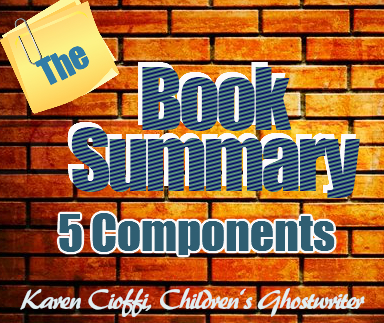
After your book query, the book summary or description is the most important marketing element. You can think of it as number 2 on the book marketing ladder.
Once your book query gets the reader to actually read it, the summary is what will entice the editor or agent to ask for more.
If you’re writing fiction, this means taking your novel, short story, or other fiction genre and reducing it, condensing it, to around 200 words. Many authors, especially new ones, have a difficult time with this. How do you turn a 35,000 children middle grade book into 200 words? How do you turn a 250,000 word novel into 200 words?
Impossible!
Well, as impossible as it may seem, that’s what you need to do to get your manuscript out your door and into a publishing house.
So, what’s involved in writing a ‘killer’ book summary?
According to Margaret Fortune, in an article at Writer’s Digest, the “synopsis [summary] is about one thing: Convincing an agent [or editor] to read your book.” (1)
Again, you book query made the editor/agent look, but it’s the summary that will have her wanting more.
The summary breaks the manuscript into five primary components:
1. Main characters
Once the reader gets to the point of reading your summary, you need to provide an engaging protagonist (main character). This very brief portrayal must demonstrate the protagonist’s individuality. The reader must be able to relate to the character through some trait, goal, peculiarity, or other.
In my middle grade fantasy adventure, “Walking Through Walls,” the protagonist didn’t want to labor in the fields like his father. He wanted more. He wanted to find the Eternals, a mystical group who had extraordinary powers. In fact, he obsessed over finding them.
This gives the protagonist a particular characteristic, an edge. It sets him apart.
2. Plot, including setting
This is one of the toughies. You want to be descriptive, but you need to make it lean. Give enough, but don’t give too much.
According to the article Shrink Tank by Grace Bello, “The key is to entice, not to reveal all.” (2)
TIP: A helpful way to condense your story is to first create 10 different elevator pitches for it. These are one or two sentences that you could convincing get out within a 30-60 second elevator ride.
Once you can narrow the manuscript down to an elevator pitch, you should find it easier to write a 200 word overview.
3. Tone
The tone is established through phrasing and even word choices, such as positive or negative words. The tone is subjective – it’s the author’s attitude toward the story or components within the story.
Write the summary in the same tone [narrative voice] as the book. If it’s humorous, make the summary humorous. If it a mystery or suspense, keep that tone in the summary.
4. Genre
The editor or agent will of course want to know the genre, so be sure to include it.
TIP: If you submit a children’s story to a romance book publisher, that editor won’t be interested in your story – no matter how well-crafted your summary is. So, be sure you research the publishing houses and/or agents you intend to submit your query and summary to. Be sure the accept submissions in your genre.
5. Comparable titles
While years ago, this wasn’t an issue, it is now. Agents and publishers want to know what they can compare your story to.
As an example, my middle grade fantasy book mentioned above, is set in 16th century China. It has the elements of respect and honor that the time period conjures up. If I had to compare it to something similar, I’d have to go with “A Single Shard,” by Linda Sue Park.
This is in no way stating it’s as good as “A Single Shard,” it’s saying that it has a similar tone and mood to that book.
TIP: Be careful with this component. You don’t want to puff your book up by comparing it to a great book. As with my example above, I’d be quick to mention that it’s only comparable in tone and mood.
References:
(1) http://www.writersdigest.com/editor-blogs/guide-to-literary-agents/tips-for-queriers-the-query-the-synopsis-and-the-first-page
(2) The Writer, October 2013, Shrink Tank, page 33.
(3) http://ourenglishclass.net/class-notes/writing/the-writing-process/craft/tone-and-mood/
MORE ON WRITING FOR CHILDREN
Book Marketing and the Query Letter
Children
’s Writing and Publishing Jargon – 11 of the Basics
What Makes a Good Story? Plot Driven vs. Character Driven

Let me take a look at it. I’m a working children’s ghostwriter, rewriter, editor, and coach. I can turn your story into a publishable and marketable book.
Shoot me an email at: kcioffiventrice@gmail.com (please put Children’s Writing Help in the Subject line)
Or, if you’d rather give it a shot and do-it-yourself, check out my book, HOW TO WRITE A CHILDREN’S FICTION BOOK.

6 thoughts on “The Book Summary – Five Must-Know Components”